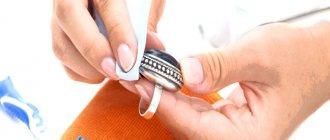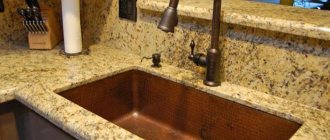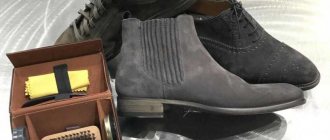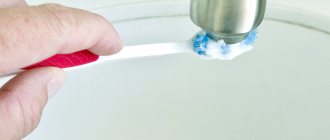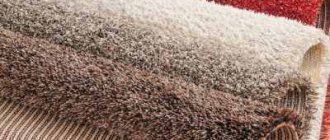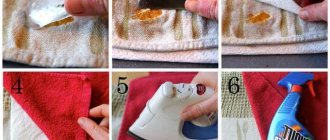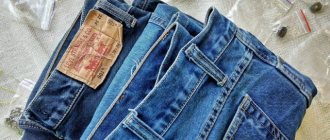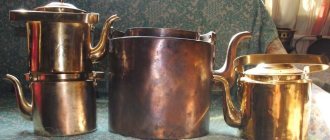How to clean a copper coin. Cleaning copper coins at home is quite simple if done correctly. This need arises from time to time for every metal, since it can oxidize and become coated. The older the product, the more susceptible it is to damage. If you know what to clean and how, then you can do it yourself without using the services of specialists. The methods are very simple and involve the use of improvised things that are found in almost every home. So, how to properly clean copper coins at home?
Universal methods
There are several methods that are guaranteed not to damage an ancient coin. They are simple, effective and do not require expensive materials. You can find the ingredients needed for cleaning on your kitchen shelf or in your medicine cabinet.
Mechanical cleaning
To clean a copper coin you will need:
- a powerful magnifying glass, or better yet, a microscope;
- bristle brushes;
- "Paraloid B72"
- cotton swabs and disks;
- scrapers;
- toothpicks, boxwood and bone needles.
- needles made of soft metal - aluminum, brass, silver.
Before starting processing, dry the copper, saturate it with “Paraloid” and dry thoroughly again. Then:
- Place the coin under a magnifying glass and begin to carefully remove the plaque with the shebbers. Do not press or scratch the copper; proceed as carefully as possible.
- Remove soft deposits with boxwood needles, and use them to clean the relief of small designs and letters.
- Use toothpicks to remove residual dirt; polish the result with a brush and cotton swabs.
This work is painstaking, but the coin will turn out perfect!
Cleaning with kefir
This product works on simple stains and effectively dissolves greens.
- Take kefir. A drink of any fat content is suitable; if you want to save a little, use an expired one, nothing bad will happen.
- Place the coin in kefir and leave for several days. Over time, the drink around the metal will darken. Drain the dirty kefir, rinse the coin and repeat the procedure.
- Keep the product in the drink until the dirt dissolves. The process may take 10-15 days.
Instead of kefir, you can use any fermented milk product: whey, ayran, tan. What is important is not the taste of the drink, but the high level of acidity.
Neutral soap
Usually, laundry soap is used to clean old coins - it is effective and cheap. But if you are working with a valuable specimen, we recommend using a child’s one. This soap is softer and has a lower pH level, which means you probably won’t damage the metal.
- Grate the soap. Estimate the volume by eye: the composition should cover the coin completely.
- Brew the soap with boiling water and leave for a couple of hours. During this time, the mixture will turn into a soft viscous substance.
- Place the coin in the solution and leave it for at least a day. Light stains will disappear during this time. Durable plaque dissolves in 1-2 weeks, and serious deposits take tens of days.
- When the plaque has softened, remove the coin, rinse it under running water and gently polish it with a soft toothbrush. If the metal is clean, finish polishing with a wool rag or felt.
- Is there dirt on your coin? Return it to the soap solution and repeat the procedure. Amateur numismatists spend months cleaning especially “killed” specimens.
If the cleaning process takes a long time, do not forget to constantly check the coin. Excessive exposure to soap will not benefit copper.
Boiling with soda
This method is very simple to perform, but effective.
- Place 3-5 tablespoons of soda in 0.5 liters of clean water.
- Boil the solution and place a coin in it.
- Continue boiling until the buildup has dissolved. This usually takes 20-30 minutes, but it all depends on the extent of the damage.
- Cool the solution, remove the coins and rinse.
The cleaned metal should be polished with a soft, non-abrasive material - felt or a soft toothbrush.
Liquid soap with citric acid
Some types of liquid soap contain citric acid. This is exactly the option you will need. If you don’t find anything suitable, make “sour” soap yourself. To do this, add 1-2 grams of regular food grade citric acid per 100 grams of product.
- Pour soap into a glass to a level of 2-3 cm.
- Place a coin in the glass.
- Leave for 10-12 hours.
- After rinsing the copper, evaluate the result. If the metal is clean, polish it. If not, repeat the procedure.
Be careful: some stains, for example, green residue, are poorly removed by soap. If you see that some stains do not go away, but in general the metal has already been cleaned, stop the procedure. If you overdo it, you will ruin the copy. The acid will leave unsightly stains on it.
It is better to remove some complex stains mechanically.
"Trilon-B"
"Trilon B" is a specialized product designed to dissolve metal salts. This product can remove the most durable oxides and does not destroy copper.
To clean metal:
- Prepare a solution of Trilon B with a strength of 5%.
- Put coins in it.
- Hold for 2-3 minutes and check the result. Some oxides dissolve completely, others become brittle. You can remove them with a toothpick, brush or school eraser.
If the metal is clean, rinse it thoroughly. Problem areas can be wiped with a cotton swab dipped in Trilon solution.
Do not leave metal in Trilon B for a long time! This is a very possible remedy. If you overdo it, Trilon will soften the copper and dissolve the relief on the hammered elements.
To avoid mistakes, practice on the simplest copies that you don’t mind losing. And only after that move on to rare valuable coins.
We recommend: How to properly and efficiently starch a crocheted product?
Coca Cola
The most common Coca-Cola contains phosphoric acid. This is an effective solvent. The acid concentration in the drink is very low, so you are sure not to damage the metal. But you are unlikely to clean it from serious contaminants either.
The Coca-Cola method is good in cases where you need to refresh the product, remove minor darkening and light patina.
- Pour cola into the container.
- Put the coins there.
- Leave for at least 12 hours. You can do it for a day, nothing bad will happen.
- Remove the items, rinse under running water and polish with a cloth.
Advice. Cola removes limescale no worse than Domestos. But, unlike aggressive chemistry, it acts gently. If your coin is covered in calcium deposits, cola is an ideal option.
Storage recommendations
It is important to clean copper coins without damaging them. Rinsing with plain water prevents the blue-green sheen called malachite, which is caused by a combination of copper, salt and oxygen.
The best way to protect coins from the environmental hazards discussed above is to use storage accessories such as folders, albums, holders, flips and slabs. Each product has advantages and disadvantages that should be considered when deciding which one is best for your collection.
- Coin folders are folding sheets of cardboard with slots. This is one of the least expensive storage options and is best for low value coins. The main disadvantage of folders is that only one side of the coin is visible in the air. As a result, toning may appear on the unexposed side. There is also a risk of coins falling out of the folder when handling it.
- Coin albums are a more sophisticated option for storing your collection than folders. The albums consist of multiple pages with holes in them, and each slot has a clear mylar strip that protects the coins and allows both sides to be seen. This is an excellent option for storing more valuable items. You need to be careful when removing them from the album because the mylar slide may leave a mark if the coin slides over it.
- The holders consist of a piece of cardboard that folds over the coin and a viewing circle covered in cellophane that displays the front and back sides. They are called "two by two" because they are usually two by two inches in size, but there are other types. Folded cardboard should be stapled, and crimping the staples will help reduce air exposure to the contents. You must be careful not to scratch the coin on the brackets when removing it from this holder. These holders cannot be reused.
- Flip - These holders are similar to 2x2s, but are made of clear plastic rather than cardboard and cellophane. The flip folds in half and can hold a coin on each side, and unlike 2x2s, they can be used many times. One of the disadvantages of flips is that the plastic usually contains PVC, which can damage the product over time. It's best to use the flip as temporary storage until a better option is found.
- Slabs are the safest option for storing individual coins. These are hard plastic holders that are usually made of inert, non-PVC plastic and are sound insulated to be as airtight as possible. Highly graded and authenticated coins from NGC, PCGS and other organizations should be stored in slabs. The only problem with them is that storing multiple slabs can be difficult. There are special types of boxes for storing multiple coin slabs.
After choosing a method, you should think about the storage location. Below are the safest places:
- The bedroom is the safest place because it usually has a comfortable temperature and humidity level. It is worth making sure that coins are stored in a room far enough away from the kitchen and bathroom so that heat, moisture and cooking oils do not affect them.
- Safe – Storing your collection in a safe at a bank is the safest option, but it can also be quite expensive. There is also a small risk of moisture exposure since bank vaults are constructed from materials that will release water vapor in the event of a fire. Over time, moisture from the storage can leak out and make the storage damp. It is recommended to place a bag of silica gel in the safe to absorb excess moisture.
- A safe for your home/office is a good and safe option for storing your coin collection. If storing them this way, you should place the silica gel packet in a safe to absorb moisture for the same reason as putting it in a safe deposit box in a bank vault.
- Metal cabinet : Wood cabinets have coatings and adhesives that contain chemicals that can be harmful. Avoid storing coins in wooden cabinets or bookshelves. It is safer to do this in a metal cabinet, but you should make sure that the latter is located in a room with low humidity levels. Metal can attract moisture and form condensation.
Effective methods, but dangerous
With these methods you will remove the most difficult stains. But if you make a mistake, you will probably damage the coin. Weigh all the risks before getting started.
Ammonia
Use this method on very dirty coins. Ammonia, also known as an alcohol solution of ammonia, is a fairly powerful solvent; it can easily remove the most durable plaque.
To remove dirt:
- Prepare a jar that can be closed with a lid.
- Pour ammonia there. The liquid level should be such as to cover the coin with a margin.
- Place the product in ammonia. Soon you will see that the liquid has turned green. Don't be alarmed, this is normal.
- Cover the jar with a lid to prevent the ammonia from evaporating.
- Soak the coin in ammonia for 5-10 minutes. It can be longer if there is really a lot of plaque. But be careful not to overdo it. You want to dissolve external contaminants without damaging the metal. The exposure time depends on the amount of plaque and dirt.
- When the product is cleaned, do not remove the coin under any circumstances! Place the jar under running water and keep it there until the ammonia rinses out.
- Take out the product, rinse, wipe.
If you are not satisfied with the result, repeat the procedure.
Ammonia is especially effective at removing copper oxide. They look like cherry red layers.
Important. Copper coated with ammonia should never come into contact with air. The metal will begin to oxidize and dark, untidy spots will appear on it. It is very difficult to remove them.
Vinegar and citric acid
Using vinegar will quickly clean your coins, but you risk ruining the coin. The acid will remove plaque and greens, but will open up all the irregularities and cavities on the metal.
Are you ready to take a risk? Then:
- Add 1 tbsp to 1 liter of water. l vinegar. Use regular store-bought 9% concentration.
- Place a coin in the vinegar solution.
- Hold for 5 minutes.
- Rinse and brush with a toothbrush.
If individual plaque fragments do not dissolve, but have softened, remove them with a pin or wooden toothpick. Wipe problem areas with a cotton swab dipped in an acidic solution. This way you will remove local contamination without damaging the already cleaned metal.
If you don't have vinegar, use citric acid. They are very similar in type of impact. Dissolve 1 tsp in 1 liter of water. acid and proceed according to the scheme described above.
Causes of pollution
Copper is a reactive metal. For example, the type of corrosion that copper experiences can be seen on old coins with dark green stains. The following are the main causes of damage that can threaten a collection:
- Moisture is the most common cause of damage as copper reacts chemically with water. It is also the most difficult environmental factor to protect against because it can get anywhere. Some coin holders are effective in reducing the risk of damage due to moisture, but effectiveness is not guaranteed.
- Extreme Temperatures : Heat does not directly harm coins, but causes other factors such as humidity, air pollution and acids to damage the piece faster than normal. Cold temperatures can also cause damage if they cause condensation on the surface.
- Acids can cause significant damage, and they usually come from coin holders and storage accessories made of paper or cardboard. The acids used in these materials can cause them to tint and dull upon contact. You should be aware of using materials that may contain acids and keep coins away from other household sources of acids, including adhesives and cleaning solutions.
- Chlorine is a harsh chemical that can severely corrode copper and cause severe tinting. Most often, coins are exposed to chlorine from plastic coin holders containing PVC (polyvinyl chloride).
- Normal air pollution can destroy a copper product over time. You need to protect your coins from the outside air as much as possible, especially in urban areas.
- Mishandling coins is a common and preventable source of damage. Acids and oils from your fingers can damage the surface of coins, so do not handle them directly.
Paste GOI
This method is used by newbie collectors. GOI paste removes blackness from metal and makes it bright and shiny. The paste does not remove serious oxides or calcium deposits.
But experienced numismatists do not approve of the use of this tool. GOI paste is soft but abrasive. During processing, you will remove light dirt, but damage the protruding elements of the coin: the edge and the design. The more you try, the more actively you remove dirt, the more you smooth out the chasing.
At the end you will get a shiny coin with “licked” small details. This is not a problem when you are cleaning your silverware. But for collectible coins this result is unacceptable.
The exception is when you need to remove a small stain on the smooth part of the coins. In this case, dip a cotton swab into the paste and carefully wipe the problem area with the tip.
What can't be used and why?
To preserve the design on coins and protect the surface from scratches and other damage, you must remember about prohibited cleaning products and methods.
The following are taboo:
- aggressive compounds - strong reagents can partially dissolve the metal and damage the image;
- abrasives - they scratch the metal surface and smooth out the three-dimensional pattern;
- strong heating - heat treatment can cause deformation of an expensive product;
- prolonged soaking in any cleaning agent can deteriorate the appearance of the coin.
If a particular product raises doubts about its effectiveness and safety, it is recommended to refrain from using it. This is especially true for radical ultra-fast methods. They may harm the coin and reduce its numismatic or modern value.
Unusual ways
Some old coin enthusiasts are experimenting with cleaning methods. They put metal in tomatoes, oranges and apples, poured grape juice and white wine. Surprisingly, these methods can work. The products listed above contain a high level of acid, which dissolves plaque. But the risk is very high:
- You will not be able to determine the acidity level of the environment. Ripe kiwi, for example, has a pleasant sweet and sour taste, but in fact there is a very high concentration of fruit acids. If you put a coin in a qiwi, you will probably ruin it.
- You do not know what active chemical elements are included in the composition of the improvised “cleaning agent”. When coins come into contact with fruits and vegetables, they may turn black, green, or stained.
Is it worth conducting such experiments at home? You decide.
Organic oil
Collectors use petroleum jelly or glycerin, but really anything will do: highly purified vegetable oil, cosmetic oil, or Johnson's Baby oil.
- Pour oil into a container and place a coin in it.
- Wait a week or two.
- Clean the copper with a scraper.
In this way you will remove minor plaque and darkening.
If soaking gives poor results, boil the coins in oil. This method is effective for cleaning well-preserved but dirty items. If you boil a heavily damaged coin, you will dissolve not only the plaque, but also the top layer of copper along with the coinage.
The coin is dipped into boiling oil for 5-7 minutes. During this time, the plaque turns into a sticky dense mass. Remove it with a brush and soapy water.
Soon you will have black but pure copper in your hands. Advice. The vapors from the oil are very flammable. During boiling, the container with oil must be covered with a lid.
Bronze exhibits
Most methods for cleaning bronze coins from dirt are similar to methods for cleaning copper products. It is also possible to use citric acid and soda. The following composition is acceptable for use: Trilon, ammonia, water and toothpaste. Properly used substances will help quickly get rid of darkening on specimens.
It is not recommended to use nitric or sulfuric acid. In this case, the acid will only be useful when cleaning inexpensive coins that are in poor condition. At the end, the surface can be smeared with sulfur ointment for shine. The procedure includes the following steps: Vaseline ointment and sulfur ointment are applied to the coin and all this is smeared over the entire surface using a toothbrush. Finally, rinse the bronze items with warm water. Thus, the coin is covered with a protective layer that protects the material from oxidation. Residues from the oil can be washed off with running water.
Household chemicals
Metal can be cleaned with liquid soap or dishwashing detergent. In this safe way, you will remove all organic contaminants and soften plaque.
- Dip the coins in the detergent and leave for a few days.
- Wipe the metal with a brush or eraser.
- Dip in soap again if necessary.
We recommend: Urgently for a date: how to remove the smell of garlic from your mouth and hands?
Unfortunately, soap does not work with complex insoluble compounds. In this case, inexperienced collectors try to clean the metal with abrasives - for example, Pemolux. Don't do this! Harsh products will scratch the copper and “erase” small details of the coinage.
Electrolysis
This is a tough but effective method. If everything goes well, you will remove the most stubborn oxides, but if everything fails, you will ruin the specimen.
For electrolysis you will need:
- plastic or glass solution tray;
- alligator clips or strong paper clips;
- 12 volt power supply;
- metal plate;
- soda;
- distilled water.
First prepare the solution: put 2/3 tbsp in 0.5 liters of water. l. soda Pour the liquid into the bath.
Then strip the wires on the power supply and identify + and -. To do this, place the stripped ends in the solution and apply power. The wire around which the water is bubbling is +.
Ready? Using paper clips or alligator clips, secure a metal plate to one of the wires and a coin to the other.
If you hang a coin on +, the reaction will take place very quickly. But in this case, the risk of overdoing it and ruining the copy increases. Set it to - and the process will slow down. You will spend a lot of time, but you will be able to control the process.
Dip the plate and coin into the solution, apply voltage to the wires and wait 10-15 minutes. Then take out the coin, wipe it and carefully polish it. If necessary, electrolyze the metal again, but replace the cloudy solution with a fresh one.
Remember: during the processing process you destroy not only oxides and plaque, but also the metal itself. Use this method only for relatively new and inexpensive collection items.
Tips and precautions
When handling chemicals, remember about your own safety and the harmlessness of the process for the specimen being cleaned. It is important not only to wash coins, but also not to spoil a valuable specimen:
- Find out what metal it is made of (silver, bronze, brass, etc.).
- After initial cleaning in a soapy solution and drying it, examine the penny for damage: chips, cracks, scratches and indentations.
- Practice on low-value specimens.
- Clean heavily soiled metal money in several stages.
- Leave the cleaning of valuable and damaged exhibits to professionals.
What not to do:
- Use abrasive products. Large particles damage the relief of the exhibit.
- Use aggressive chlorine-containing products.
- Use hard tap water, which contains chlorine impurities. This substance oxidizes the metal.
Drying coins
You have cleaned all the dirt, washed the coins and rinsed them. But this is not enough! While washing, you took the coins with your hands, which means you left faint traces of grease and sweat on them. After a few years, such prints will turn into a black, indelible coating. To prevent this from happening:
- Degrease the metal with alcohol or acetone. But don't rub the coins with a rag! Use only cotton swabs.
- Dry the copper. To speed up the process, use a hairdryer or a regular table lamp - it provides enough heat. Handle coins either with sterile gloved hands or with tweezers.
Processing 1 copy will take you 1-3 minutes.
Types of funds
There are special means and tools for cleaning copper coins:
- Folk. These are harmless compounds, which include lemon, vinegar, salt, toothpaste, etc. They are always at hand and remove plaque well.
- Chemical. Such tools save time and give good results.
- Mechanical impact. The cleaning process may require a needle, a cotton swab, a soft cloth, a brush, cutters, gloves, and tweezers. They allow you to remove dirt even in hard-to-reach places.
These products will help cope with moderate to mild plaque.
Ammonia
How to store coins after cleaning?
You cannot store the collection on a shelf under glass. Coins are placed in cotton bags, holders or in plastic capsules of coolers, each copy separately.
Place the packaged collection in a special tablet or in a regular box with cells and place it in a warm, dry place. There should be no temperature changes there.
Serious collectors store their collections in special containers that protect metals from corrosion - for example, Intercept-shield.
